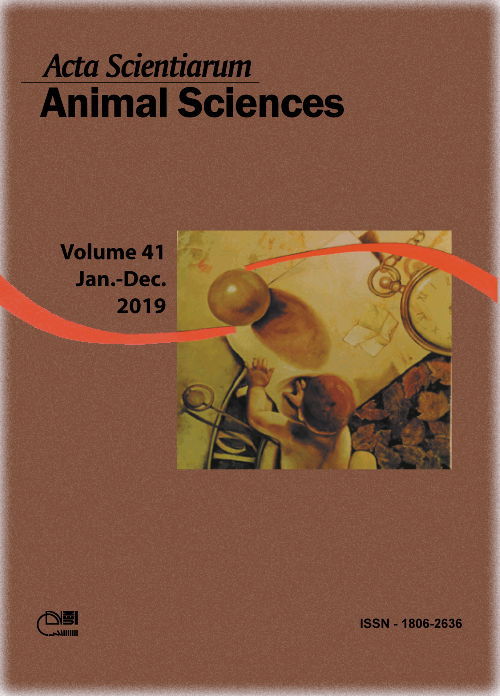Leaf tissue flows and defoliation patterns of Alexandergrass grazed by heifers receiving energy supplement
Abstract
The study was carried out to evaluate defoliation patterns and to quantify leaf tissue flows in Alexandergrass (Urochloa plantaginea (Link.) Hitch) grazed by beef heifers receiving whole rice bran in three levels of supplementation (0, 0.5 and 1 % of body weight). A rotational stocking grazing method and two area replications were utilized. The experimental design was completely randomized following a repeated measure arrangement. The supply of rice bran to heifers grazing Alexandergrass increased the stocking rate by 13%. Regardless of the feeding system, the heifers grazed the expanding leaf blades in the top stratum of the canopy more frequently compared to other types of leaf. Leaf tissue flows, leaf blade intake and grazing intensity have not been changed by supplement fed.
Downloads
References
Bargo, F., Muller, L. D., Kolver, E. S., & Delahoy, J. E. (2003). Invited review: Production and digestion of supplemented dairy cows on pasture. Journal of Dairy Science, 86(1), 1-42. doi: 10.3168/jds.S0022-0302(03)73581-4.
Bircham, J. S., & Hodgson, J. (1983). The influence of sward condition on rates of herbage growth and senescence in mixed swards under continuous stocking management. Grass and Forage Science, 38(4), 323-331. doi: 10.1111/j.1365-2494.1983.tb01656.x.
Carrere, P., Louault, F., & Soussana, J. F. (1997). Tissue turnover within grass-clover mixed swards grazed by sheep. Methodology for calculating growth, senescence and intake fluxes. Journal of Applied Ecology, 34(2), 333-348. doi: 10.2307/2404880.
Difante, G. S., Nascimento Júnior, D., Silva, S. C., Euclides, V. P. B., & Montagner, D. B. (2011). Características morfogênicas e estruturais do capim-marandu submetido a combinações de alturas e intervalos de corte. Revista Brasileira de Zootecnia, 40(5), 955-963. doi: 10.1590/S1516-35982011000500003.
Eloy, L. R., Rocha, M. G., Pötter, L., Salvador, P. R., Stivanin, S. C. B., & Hampel, V. S. (2014). Biomass flows and defoliation patterns of alexandergrass pasture grazed by beef heifers, receiving or not protein salt. Acta Scientiarum. Animal Sciences, 36(2), 123-128. doi: 10.4025/actascianimsci.v36i2.21815.
Empresa Brasileira de Pesquisa Agropecuária [EMBRAPA]. (2006). Sistema brasileiro de classificação de solos. Rio de Janeiro, RJ: Embrapa Solos.
Gastal, F., & Lemaire, G. (2015). Defoliation, shoot plasticity, sward structure and herbage utilization in pasture: Review of the underlying ecophysiological processes. Agriculture, 5(4), 1146-1171. doi: 10.3390/agriculture5041146.
Gomide, C. A. M., & Gomide, J. A. (1999). Growth analysis of Panicum maximum Jacq. cultivars. Revista Brasileira de Zootecnia, 28(4), 675-680. doi: 10.1590/S1516-35981999000400003.
Hodgson, J. (1981). Variations in the surface characteristics of the sward and the short-term rate of herbage intake by calves and lambs. Grass and Forage Science, 36(1), 49-57. doi: 10.1111/j.1365-2494.1981.tb01538.x
Hodgson, J. (1990). Grazing management. Science into practice. London, UK: Longman Group UK Ltd.
Lemaire, G., & Chapman, D. (1996). Tissue flows in grazed plant communities. In J. Hodgson & A. W. Illius (Eds.), The ecology and management of grazing systems (p. 3-36). Wallingford, UK: CAB International.
Moreira, L. M., Santos, M. E., Fonseca, D. M., Martuscello, J. A., Morais, R. V., & Mistura, C. (2011). Produção animal em pastagem de capim-braquiária adubada com nitrogênio. Arquivo Brasileiro de Medecina Veterinária e Zootecnia, 63(4), 914-921. doi: 10.1590/S0102-09352011000400017.
Oliveira Neto, R. A., Silva, J. H. S., Rocha, M. G., Pötter, L., Sichonany, M. J. O., Biscaíno, L. L., ... Difante, M. V. B. (2013). Ingestive behavior, performance and forage intake by beef heifers on tropical pasture systems. Revista Brasileira de Zootecnia, 42(8), 549-558. doi: 10.1590/S1516-35982013000800003.
Paiva, A. J., Silva, S. C., Pereira, L. E. T., Guarda, V. D. Á., Pereira, P. M., & Caminha, F. O. (2012). Structural characteristics of tiller age categories of continuously stocked marandu palisade grass swards fertilized with nitrogen. Revista Brasileira de Zootecnia, 41(1), 24-29. doi: 10.1590/S1516-35982012000100004.
Pompeu, R. C. F. F., Cândido, M. J. D., Neiva, J. N. M., Rogério, M. C. P., Benevides, Y. I., & Oliveira, B. C. M. (2009). Fluxo de biomassa em capim-tanzânia sob lotação rotativa com quatro níveis de suplementação concentrada. Revista Brasileira de Zootecnia, 38(05), 809-817. doi: 10.1590/S1516-35982009000500005.
Pontes, L. S., Carvalho, P. C. F., Nabinger, C., & Soares, A. B. (2004). Fluxo de biomassa em pastagem de azevém anual (Lolium multiflorum Lam.) manejada em diferentes alturas. Revista Brasileira de Zootecnia, 33(2), 529-537. doi: 10.1590/S1516-35982004000300002.
Pötter, L., Rocha, M. G., Roso, D., Costa, V. G., Glienke, C. L., & Rosa, A. N. (2010). Suplementação com concentrado para novilhas de corte mantidas em pastagens cultivadas de estação fria. Revista Brasileira de Zootecnia, 39(5), 992-1001. doi: 10.1590/S1516-35982010000500008.
Rouquette Junior, F. M. (2016). Invited review: The roles of forage management, forage quality, and forage allowance in grazing research. The Professional Animal Scientist, 32(1), 10-18. doi: 10.15232/pas.2015-01408.
Salvador, P. R., Pötter, L., Rocha, M. G., Eloy, L. R., Hampel, V. S., Stivanin, S. C. B., ... Sichonany, M. J. O. (2014). Fluxos de tecidos foliares em papuã sob pastejo de bezerras de corte em diferentes frequências de suplementação. Revista Brasileira de Saúde e Produção Animal, 15(4), 835-845. doi: 10.1590/S1519-99402014000400004.
Statistical Analysis System [SAS]. (2013). User’s guide - Version 9.4. Cary, NC: SAS Institute Inc.
Sichonany, M. J. O., Rocha, M. G., Pötter, L., Oliveira, A. P. B. B., Ribeiro, L. A., Silva, M. F., ... Salvador, P. R. (2015). Ingestive behavior of heifers in Alexandergrass pasture receiving different amounts of oat grain as supplement. Semina: Ciências Agrárias, 36(4), 2763-2774. doi: 10.5433/1679-0359.2015v36n4p2763.
DECLARATION OF ORIGINALITY AND COPYRIGHTS
- I Declare that current article is original and has not been submitted for publication, in part or in whole, to any other national or international journal.
The copyrights belong exclusively to the authors. Published content is licensed under Creative Commons Attribution 4.0 (CC BY 4.0) guidelines, which allows sharing (copy and distribution of the material in any medium or format) and adaptation (remix, transform, and build upon the material) for any purpose, even commercially, under the terms of attribution.
Read this link for further information on how to use CC BY 4.0 properly.








































